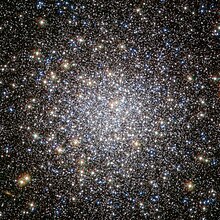Messier 5
| Messier 5 | |
|---|---|
 Globular cluster Messier 5 in Serpens | |
| Observation data (J2000 epoch) | |
| Class | V[1] |
| Constellation | Serpens |
| Right ascension | 15h 18m 33.22s[2] |
| Declination | +02° 04′ 51.7″[2] |
| Distance | 24.5 kly (7.5 kpc)[3] |
| Apparent magnitude (V) | +5.95[4] |
| Apparent dimensions (V) | 23′.0 |
| Physical characteristics | |
| Mass | 8.57×105[5] M☉ |
| Radius | 80 ly |
| Metallicity | = –1.12[6] dex |
| Estimated age | 10.62 Gyr[6] |
| Other designations | NGC 5904, GCl 34[4] |
Messier 5 or M5 (also designated NGC 5904) is a globular cluster in the constellation Serpens. It was discovered by Gottfried Kirch in 1702.
Discovery and visibility[]
M5 is, under extremely good conditions, just visible to the naked eye as a faint "star" 0.37 of a degree (22' (arcmin)) north-west of star 5 Serpentis. Binoculars and/or small telescopes resolve the object as non-stellar; larger telescopes will show some individual stars, some of which are as bright as apparent magnitude 10.6.[7] M5 was discovered by German astronomer Gottfried Kirch in 1702 when he was observing a comet. Charles Messier noted it in 1764 and—a studier of comets—cast it as one of his nebulae. William Herschel was the first to resolve individual stars in the cluster in 1791, counting roughly 200.[8]
Notable stars[]
One hundred and five stars in M5 are known to be variable in brightness, 97 of them belonging to the RR Lyrae type. RR Lyrae stars, sometimes referred to as "Cluster Variables", are somewhat similar to Cepheid type variables and as such can be used as a tool to measure distances in outer space since the relation between their luminosities and periods are well known. The brightest and most easily observed variable in M5 varies from magnitude 10.6 to 12.1 in a period of just under 26.5 days.[7]
A dwarf nova has also been observed in this cluster.[9]

See also[]
- List of Messier objects
References[]
- ^ Shapley, Harlow; Sawyer, Helen B. (August 1927), "A Classification of Globular Clusters", Harvard College Observatory Bulletin, 849 (849): 11–14, Bibcode:1927BHarO.849...11S.
- ^ a b Goldsbury, Ryan; et al. (December 2010), "The ACS Survey of Galactic Globular Clusters. X. New Determinations of Centers for 65 Clusters", The Astronomical Journal, 140 (6): 1830–1837, arXiv:1008.2755, Bibcode:2010AJ....140.1830G, doi:10.1088/0004-6256/140/6/1830.
- ^ Paust, Nathaniel E. Q.; et al. (February 2010), "The ACS Survey of Galactic Globular Clusters. VIII. Effects of Environment on Globular Cluster Global Mass Functions", The Astronomical Journal, 139 (2): 476–491, Bibcode:2010AJ....139..476P, doi:10.1088/0004-6256/139/2/476, hdl:2152/34371.
- ^ a b "M 5". SIMBAD. Centre de données astronomiques de Strasbourg. Retrieved 2006-11-15.
- ^ Boyles, J.; et al. (November 2011), "Young Radio Pulsars in Galactic Globular Clusters", The Astrophysical Journal, 742 (1): 51, arXiv:1108.4402, Bibcode:2011ApJ...742...51B, doi:10.1088/0004-637X/742/1/51.
- ^ a b Forbes, Duncan A.; Bridges, Terry (May 2010), "Accreted versus in situ Milky Way globular clusters", Monthly Notices of the Royal Astronomical Society, 404 (3): 1203–1214, arXiv:1001.4289, Bibcode:2010MNRAS.404.1203F, doi:10.1111/j.1365-2966.2010.16373.x.
- ^ a b Coutts Clement, Christine M.; Sawyer Hogg, Helen (August 1977). "The Bright Variable Stars in Messier 5". Journal of the Royal Astronomical Society of Canada. 71: 281. Retrieved 1 March 2021.
- ^ "William Herschel's Observations of the Messier Objects". www.messier.seds.org. Students for the Exploration and Development of Space. Retrieved 1 March 2021.
- ^ Neill, James D.; Shara, Michael M.; Caulet, Adeline; Buckley, David A.H. (June 2002). "The first orbital period for a dwarf nova in a globular cluster: V101 in M5". The Astronomical Journal. 123 (6): 3298–3304. doi:10.1086/340469. Retrieved 1 March 2021.
External links[]
| Wikimedia Commons has media related to Messier 5. |
- SIMBAD: M5
- M5,SEDS Messier pages
- M5, Galactic Globular Clusters Database page
- Historic observations of M5
- Image of M5 by Waid Observatory
- Messier 5 on WikiSky: DSS2, SDSS, GALEX, IRAS, Hydrogen α, X-Ray, Astrophoto, Sky Map, Articles and images
Coordinates: ![]() 15h 18m 33.75s, 02° 04′ 57.7″
15h 18m 33.75s, 02° 04′ 57.7″
- Globular clusters
- Serpens (constellation)
- NGC objects
- Messier objects
- Astronomical objects discovered in 1702
![{\displaystyle {\begin{smallmatrix}\left[{\ce {Fe}}/{\ce {H}}\right]\end{smallmatrix}}}](https://wikimedia.org/api/rest_v1/media/math/render/svg/4c0821bd80891e071c08e7c7ee8e022baedf522c)
